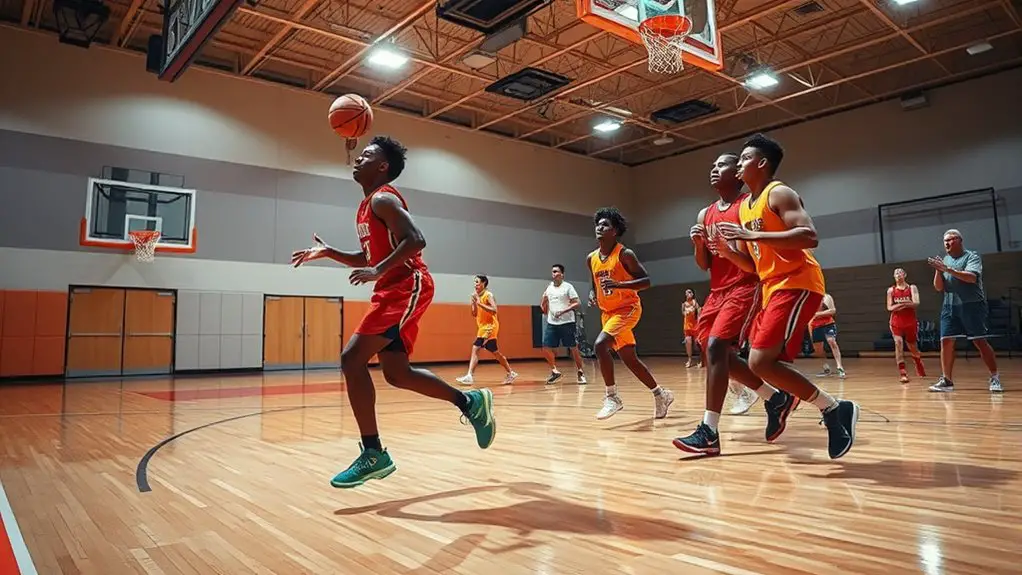To build endurance for 18-hole rounds, you should focus on cardio workouts like jogging or cycling, aiming for three sessions a week. Incorporate strength training, especially core exercises, to enhance stability. Nutrition's key too—stay hydrated, snack light before playing, and avoid sugary drinks. Don't forget mental conditioning; practice mindfulness and visualization to boost focus and resilience. There's a lot more you can do to enhance your game, so keep exploring different strategies.
Understanding the Physical Demands of Golf
While many think of golf as a leisurely sport, understanding the physical demands of the game reveals a different story. You may picture an easy day on the course, but the truth is, golf requires a blend of strength, flexibility, and stamina. Mastering swing mechanics is vital; each shot demands precise movements that can wear you out over 18 holes. If you're not careful, poor technique can lead to fatigue and even injury.
Course management plays a significant role too. Knowing when to conserve energy or push for a better score can make or break your game. You need to stay mentally sharp and physically capable, balancing your strategy with endurance. Embracing these physical challenges lets you enjoy the freedom of the game, allowing you to focus on your performance instead of fatigue. Incorporating cross-training benefits into your routine can enhance your overall fitness, making those long rounds more manageable. So, gear up and get ready to embrace the full spectrum of what golf demands from you!
Developing a Cardio Routine
To improve your endurance on the golf course, incorporating a solid cardio routine is essential. Start by mixing in aerobic exercises like jogging, cycling, or swimming. These will get your heart pumping and build stamina, allowing you to stay fresh throughout your round.
Interval training is another key component. By alternating between high-intensity bursts and lower-intensity recovery periods, you'll boost your cardiovascular fitness more efficiently. For example, sprint for 30 seconds, then walk for a minute, repeating this for 20-30 minutes. This approach not only enhances endurance but also increases metabolism post-workout.
Aim for at least three cardio sessions a week, gradually increasing duration and intensity. You'll find that your overall energy levels improve, making those long 18-hole rounds feel much easier. Remember, the goal is to keep moving freely on the course, so choose activities you enjoy. This way, you'll stay committed and have fun while building the endurance you need.
Strength Training for Stability and Power
Strength training is essential for building the stability and power necessary for an effective golf swing. When you focus on core exercises, you're not just strengthening your torso; you're enhancing your overall balance and control. A strong core allows you to generate more power during your swing, leading to longer drives and better accuracy.
Incorporating resistance training into your routine will help you build muscle and improve your endurance for those long 18-hole rounds. Think about using free weights, resistance bands, or bodyweight exercises to challenge your muscles in different ways. Squats and deadlifts, for example, are excellent for developing lower body strength and stability.
Don't forget about functional movements that mimic the golf swing—rotational exercises are key. The more stable you are, the more freedom you'll feel in your movements, allowing you to play your best game. Embrace strength training, and you'll notice a significant difference in your performance on the course.
Nutrition and Hydration Strategies
Your physical training doesn't stop at the gym; nutrition and hydration play an essential role in your performance on the golf course. To keep your energy levels up during those 18 holes, think about your pre round snacks. Opt for something light yet energizing, like a banana or energy bar, about 30 to 60 minutes before tee-off. This'll give you the fuel you need without weighing you down.
Hydration timing is vital, too. Start hydrating the day before your round, and keep sipping water throughout the day. Aim for about 16 ounces of water an hour before you start playing. During your round, take small sips regularly, even if you don't feel thirsty. Avoid sugary drinks that can lead to an energy crash. By managing your nutrition and hydration wisely, you'll set yourself up for a strong, focused performance on the course. Proper hydration(keeping a water bottle accessible) supports the freedom of playing your best game!
Mental Conditioning for Focus and Resilience
While physical training is essential for endurance in golf, mental conditioning can make all the difference when it comes to maintaining focus and resilience on the course. Implementing mindfulness techniques and visualization exercises can elevate your game to new heights.
| Mindfulness Techniques | Visualization Exercises | Benefits |
|---|---|---|
| Deep breathing | Picture your perfect shot | Reduces anxiety and enhances focus |
| Body scanning | Imagine the course layout | Increases confidence and clarity |
| Mindful walking before teeing off | Visualize post-round success | Prepares your mind for challenges |
Incorporating these practices into your routine helps you stay present and engaged, allowing you to enjoy the freedom of the game. As you cultivate mental resilience, you'll find it easier to bounce back from setbacks, keeping your focus sharp throughout the entire 18 holes. Additionally, mindfulness enhances focus and reduces anxiety, fostering a calm mindset essential for peak performance.
Frequently Asked Questions
How Can I Prevent Blisters During Long Rounds of Golf?
To prevent blisters during long rounds of golf, focus on your sock materials. Choose moisture-wicking socks made from synthetic fibers or merino wool, as they help keep your feet dry and reduce friction. Make sure your shoes fit well and don't rub against your skin. You might also consider applying blister prevention products like patches or lubricants on prone areas. With the right gear, you can enjoy your game without discomfort holding you back.
What Gear Should I Wear for Maximum Comfort?
You'd think wearing uncomfortable gear is a rite of passage for golfers, but it doesn't have to be! For maximum comfort, invest in quality golf shoes that fit well and provide support. Don't forget to check the weather; breathable, moisture-wicking clothing can make a world of difference. Layer up with weather gear if it's chilly or rainy, so you can focus on your game without the distractions of discomfort. Enjoy that freedom on the course!
Are There Specific Stretches for Golfers Before a Round?
Yes, there are specific stretches you can do before a round to enhance your golfer flexibility. Focus on dynamic warm-ups like arm circles, leg swings, and torso twists to get your blood flowing. These movements not only prepare your muscles but also help prevent injuries. You'll feel freer in your swing and more agile on the course. Just a few minutes of these stretches can make a significant difference in your performance.
How Do I Recover After an Exhausting 18-Hole Round?
After an exhausting 18-hole round, it's essential to focus on recovery. First, hydrate! Water and electrolyte drinks are key hydration strategies to replenish lost fluids. Then, think about post-round nutrition; a balanced meal with protein and healthy carbs will help your muscles recover. Don't forget to stretch lightly to ease any tension. By taking these steps, you'll feel more energized and ready for your next round. Enjoy the freedom to play your best!
Can Mental Fatigue Affect My Physical Endurance on the Course?
Absolutely, mental fatigue can impact your physical endurance on the course. When your mind's drained, it's tough to maintain focus and energy. You need to build mental resilience through practice and focus techniques, like visualization or deep breathing. These strategies not only help you stay sharp but also boost your overall stamina. So, prioritize your mental game just as much as your physical training, and you'll feel the difference on the course.




